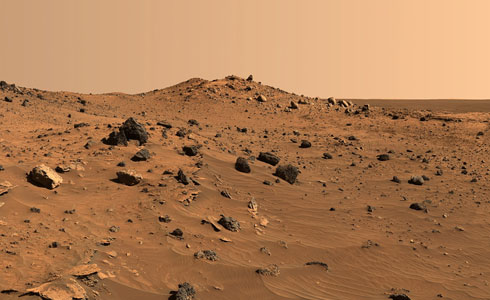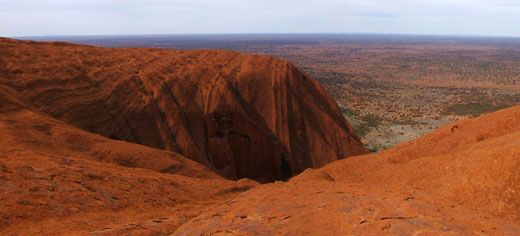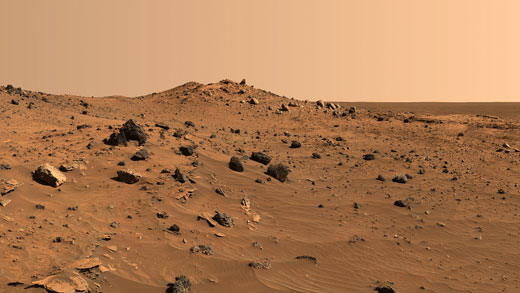What do Mars and Australia have in common?

If you’re expecting a punchline to that title, then guess again. It’s no joke. Surprisingly, Australia shares some remarkably similar geology to our neighbouring planet. Specifically the Red Centre, the arid heart of Australia, is the most Mars-like place on Earth!
It’s possible that people may have mused on the similarities already. After all, with its strikingly rich colours, the Red Centre (more often known as the Outback) certainly looks like few other places on Earth. Without any vegetation, the colour of the soil and rocks in the region could easily resemble Mars in places. But evidently, this resemblance is more than just skin deep. The clue that lead to this fascinating realisation? Another of Australia’s most beautiful and iconic of things – opals.

Patrice Rey at the University of Sydney’s School of Geosciences was investigating how opals formed. It may be surprising to learn that opals are found in few other places on Earth, with roughly 90% of all opals worldwide having originated in Australian mines. Beautiful and sought after, there’s been a lot of mystery behind opals for a long time – specifically about how they form, why they’re found at such shallow depths under the Australian soil, and why they’re found nearly nowhere else on Earth.
The story of these beautiful sparkly gemstones, it turns out, began around 100 million years ago. At the time, most of central Australia was covered by the Eromanga Sea. In times past, this huge epicontinental (inland) sea covered what is now known as the Eromanga Basin – spanning an area of one million square kilometres and reaching into much of what is now Queensland, the Northern territories, South Australia and New South Wales.
During the Cretaceous period, when dinosaurs still ruled our planet, this sea would have been teeming with prehistoric life. But much like the dinosaurs, the Eromanga Sea was doomed. Around 100 million years ago, the climate of Earth began to change and the sea began to dry out. The sea dried out rapidly on geological timescales, to cover a much smaller area. The result was that the chemistry of the surrounding rocks began to change.
As the Eromanga Sea dried out, pyrite minerals in the surrounding rocks began to release sulfuric acid, causing acid weathering on a huge scale – quite possibly the largest Earth has ever seen. The opaline silica which was created in the Australian rocks during this process would later go on to form into opals. But the big clue is the acid weathering – we only know of one other place in the Solar System where this has happened in the past. Planet Mars.
While the predicament of prehistoric Australia is, as far as we know, unique on Earth, Mars actually shares a lot in common with this event. Except on Mars, we believe that the drying out of seas happened on a global scale. Hints of this were detected in 2008, when NASA’s twin Mars rovers, Spirit and Opportunity, detected several telltale clues in the Martian soil.
The surface of Mars was found to hold opaline silica, iron oxides, and certain types of clay. All of these clues led areologists* to conclude that the surface of Mars had been subject to huge amounts of acid weathering. The exact same type of acid weathering which Rey and his fellow researchers have now discovered to have happened in Australia!

If you’re thinking that this means that there may be Martian opals waiting to be discovered somewhere on the planet next door, it’s hard to say. But it’s certainly a possibility! There is, however, one final step in the formation of opals. The opaline silica which was found on Mars is not yet true opal. In Australia, the surrounding rock has an impressive capability to neutralise acid. This means that after the ground in Australia became riddled with opaline silica, the surrounding conditions quickly went from acid to alkaline. When this happens before the silica trapped in rock cavities dehydrates and solidifies – voila! Opals! Of course, there’s a good chance that Mars may be home to some kinds of rock which can also neutralise acid the same way.
So only time will tell. Perhaps someday in the future, Martian colonists may be using Mars opals to create the first ever jewellery made elsewhere in the Solar System!
*An areologist studies the geology of Mars, seeing as technically the “geo” in geology refers to planet Earth.

Hammonds M (2013-06-11 00:29:45). What do Mars and Australia have in common?. Australian Science. Retrieved: Dec 13, 2025, from https://ozscience.com/geology/what-do-mars-and-australia-have-in-common/
 Follow
Follow
2 thoughts on “What do Mars and Australia have in common?”
Comments are closed.